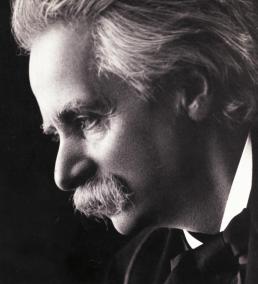Edvard Grieg

Edvard Grieg
Edvard Hagerup Grieg (Greig) was born on on June 15, 1843, in Bergen, Norway. His father, named Alexander Greig (originally McGregor), was English consul of Scottish origin. His mother, named Gesine Hagerup, was an educated pianist. Grieg grew up among three sisters and an elder brother. He began piano studies with his mother at the age of six. His mother's brother-in-law, a famous violinist Ole Bull, recommended Grieg to study at the Leipzig Conservatory. From 1858-1862 he studied music in Leipzig under the tutelage of Ignaz Moscheles and graduated with honors. From 1863-1866 Grieg lived in Copenhagen, where he continued his music studies with 'Niels W. Gade'. He made progress towards Scandinavian folk music while being an apprentice of Rikard Nordraak. Soon Grieg emancipated himself from the German romantic tradition and grew towards the development of his original style. Grieg's harmonies became unorthodox, rich, and challenging for a public conditioned to classic compositions of Mozart and Haydn. During the winter of 1865-1866 he was in Rome, where he performed his music and earned a European reputation.
His love of the Norwegian folk culture and traditional melodies became evident in his compositions written after 1866, the year Grieg returned to Norway. He settled in Christiania (Oslo) and established himself as a music teacher and concert performer. At the same time Grieg became the founder of a concert society "Eutherpe" with a choir and a symphony orchestra. His collection of "Lyrical Pieces" for piano made him a fine reputation among musicians. Grieg was called the "Chopin of the North" by Hans Bulow. In 1867 Grieg married his cousin Nina Hagerup, and their only child died being only one year old. His famous Piano Concerto in A minor was completed in 1868 and performed in Copenhagen. With a letter of recommendation from Franz Liszt, Grieg received a state stipend for his studies in Italy and spent a winter of 1869-1870 in Rome. There Grieg performed his music and had meetings with Franz Liszt and other European musicians. His collaboration with Norwegian writer Bjornson also began in Rome. During the 1870's Grieg and Bjornson made several dramatic compositions together. In 1876 Grieg was asked by Henrik Ibsen to write the incidental music to "Peer Gynt", a play about the Norwegian folk hero. Later Grieg made two "Peer Gynt" Suites for concert performances, which scored international success.
In 1872 Grieg was made a member of the Royal Music Society in Stockholm, Sweden. In 1874 Grieg was awarded the state annual grant of 1600 kronen from the Norwegian Storthing. He quit teaching and returned to his hometown of Bergen. There he chose a natural environment for his work. Grieg composed much of his music among the picturesque landscape of forest, mountains, and sea at the Hardanger fjord. There he had a cottage with a Steinway baby grand piano. Grieg's admiration with serenity and beauty of the Norwegian landscapes was the essential part of his music. Grieg wrote music of a distinguished lyrical quality and emotional depth, which he expressed through refined melody lines and sophisticated harmonic changes. His symphonic "Norwegian dances" and "Norwegian peasant dances" allude to Scandinavian folk melodies. The "Peer Gynt" suites and such pieces as "Solvejg's Song" and "Ein Schwan" are characterized with power for creating pictures in the listener's mind, which made them suitable for many film scores.
From 1878-1880 Grieg and his wife Nina, a professional singer, went on a two-year journey. Grieg performed in many cities of Europe. He was giving performances of his Piano Concerto in London during the 1880s and 1890s. Grieg died on September 4, 1907, in Bergen, Norway, and was laid to rest in a mountain cave at his countryside estate in Troldhaugen, Norway. His wife Nina lived to the age of 90 and made Grieg's villa in Troldhaugen into a museum. A concert hall was built nearby to house the annual festivals of Grieg's music.
IMDb Mini Biography By: Steve Shelokhonov
